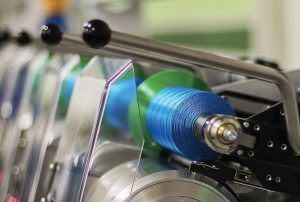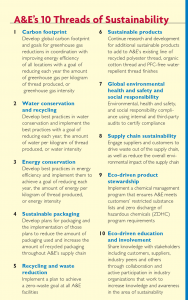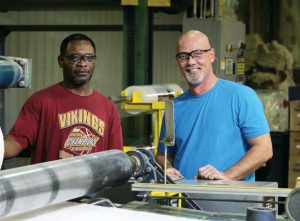
TW Special Report
The landmark National Environmental Policy Act of 1969 (NEPA) made it U.S. policy to better protect the environment and promote sustainability. To achieve this laudable goal, virtually everyone must participate — companies, consumers, state and local governments and institutions. Proudly, the U.S. textile industry has been a pacesetter in this important area by routinely exceeding government mandates.
Albert Einstein once said, “We cannot solve our problems with the same thinking we used when we created them.” This commitment to a new way of thinking is why many U.S. textile companies have altered production methodologies, adopted sophisticated recycling programs and instituted zero net waste policies to ensure the protection of our environment and natural resources. Two that stand out are American & Efird LLC (A&E), and the Jones Family of Companies.
Founded in 1891, Mount Holly, North Carolina-based A&E is a global company and among the world’s foremost manufacturers of sewing thread, embroidery thread and technical textiles.
“A core part of our business strategy is to operate all of our global facilities in a sustainable manner,” said A&E CEO Les Miller in the company’s most recent sustainability report. “It is not only a good business practice to do so, but it is the right thing to do for all of our stakeholders.”
“A&E is proud to be at the forefront of sustainability,” said Jimmy Summers, A&E’s vice president – Environmental, Health & Safety/ Sustainability. “A&E helped pioneer transparency in the thread industry by sharing its first sustainability report in 2010, which incorporated actual performance data and targets.”
Summers noted that the company maintains a program called “The Ten Threads of Sustainability.” Each thread addresses an area of environmental responsibility and outlines A&E’s commitment.
 A&E views this as a journey and not a destination, and while it has made some significant progress, the objective is to continue pressing the envelope in regard to its environmental goals. For example, Summers reports that the company has recycled and reused more than 1.1 billion liters of wastewater since 2013. Furthermore, 16 operations and support facilities have achieved 100-percent zero-waste-to-landfill status. Overall, from 2006 to 2016, the company reduced its worldwide greenhouse gas intensity by 6 percent and reduced its global power consumption by 10 percent when measured in kilowatts per kilogram of thread manufactured. Forty-four percent of the fuels used to create steam at A&E dyeing operations were renewable and carbon neutral in 2016.
A&E views this as a journey and not a destination, and while it has made some significant progress, the objective is to continue pressing the envelope in regard to its environmental goals. For example, Summers reports that the company has recycled and reused more than 1.1 billion liters of wastewater since 2013. Furthermore, 16 operations and support facilities have achieved 100-percent zero-waste-to-landfill status. Overall, from 2006 to 2016, the company reduced its worldwide greenhouse gas intensity by 6 percent and reduced its global power consumption by 10 percent when measured in kilowatts per kilogram of thread manufactured. Forty-four percent of the fuels used to create steam at A&E dyeing operations were renewable and carbon neutral in 2016.
“In our view, a sustainability program cannot be sustainable unless companies consider the health and well-being of their associates,” said Summers. “For this reason, safety is a core part of A&E’s sustainability program, promoting safe working environments by using tools such as safety audits, residual risk reduction and SNAP — or Stop, Notice, Act and Prevent, which is an observation feedback program designed to engage our associates and encourage their participation in the safety process.”
Said CEO Miller: “Sustainability is ingrained in the culture of A&E. We strive to earn the continued trust of our customers through our high-quality products, services and sustainability performance.”
Another organization that has a long history of conservation and recycling is the Humboldt, Tennessee-based Jones Family of Companies. “We have developed many products with sustainable principles as the blueprint for product differentiation and performance efficacy,” said Patrick Owens, vice president, strategic marketing, Nonwovens.

harvest plants and textile waste.
Founded in 1936, the company is a family-owned business comprised of Jones Yarn and Jones Nonwovens. The yarn business combines natural and man-made fibers — including recycled textile by-products — into yarns that are used in floor care tools like mops. The nonwovens side of the business produces nonwoven materials from natural fibers including reclaimed cotton, wool, jute and hemp. In addition to packaging, these fibers can be used in such applications as cotton batting for fire barriers, mattress insulation and other thermal insulation applications.
The company recently announced a doubling of capacity at its Jones Nonwovens plant located in North Las Vegas, Nevada. The expansion was in part to meet market needs for thicker and more resilient sustainable and natural material products for mattresses, which are beginning to replace synthetic components and foam.
Jones Nonwovens has recently also been making headlines for its new biodegradable Synchronicity packaging, a more environmentally friendly option to the polystyrene foam common in a lot of cold packaging.
“In the United States, almost a quarter of all landfill waste comes from packaging and containers, a significant number that will continue to grow without drastic intervention,” Owens said. “For decades, this destructive packaging has been synonymous with non-biodegradable petroleum-based products.”
Synchronicity combats this problem by using bast and cotton fibers from post-harvest plants and textile waste. Natural fibers exhibit many of the same properties as packaging material currently on the market, allowing for thermal management and protection. But they also decompose over time, returning naturally to the environment. Jones Nonwovens proclaims that the recyclable properties of natural fibers “make them the ecological choice for a farm-to-packaging process that shortens the cold chain at no added cost.”
“As for the name, Synchronicity, we were trying to put together a message that would be representative of the Jones philosophy and the emerging trends in the marketplace,” Owens said. “We knew there was a tremendous amount of concern, particularly among millennials, about waste and packaging, and we felt there were solutions that could be created. The name Synchronicity describes the harmonious relationship between material applications and consumer desires.”
Owens continued: “Our first focus has been on packaging, particularly thermal-insulated packaging. This is especially timely as a rise in e-commerce has necessitated the use of a lot of packaging materials.” He cited home grocery and food orders as examples. “Consumers ordering these perishable meals once or twice a week have begun to build up a lot of waste,” Owens said.
Jones’ history of recycling and repurposing began many years ago. The company first became known in the cotton industry. “Our company has deep roots in cotton,” Owens said. “Our philosophy has always been to make the best use of materials. It became one of our core competencies years ago to process materials that were not first grade. We would use such materials as gin byproducts, while the high-quality cotton would be sent to traditional textile companies. We would repurpose these into value-added products, while at the same time eliminating some of the waste produced by the gin. This is why we say we have a history of sustainability. We have been doing this for a long time. We became very good at working with materials that have been discarded and bringing them back into value-added applications.”
Owens also said Jones Nonwovens has joined the Sustainable Packaging Coalition (SPC), an initiative that brings together companies, educational institutions and government agencies involved with the packaging supply chain. Goals of the SPC include a collective development of resources and the implementation of packaging solutions.
“We see this as a great opportunity to work with like-minded companies as we strive to develop our efforts in the world of sustainable packaging,” Owens said.
Editor’s Note: This article appears in Textile World courtesy of the National Council of Textile Organizations (NCTO) as part of the “American Textiles: We Make Amazing™” campaign. NCTO is a trade association representing U.S. textile manufacturing. Please visit ncto.org to learn more about NCTO, the industry and the campaign.
July/August 2018




